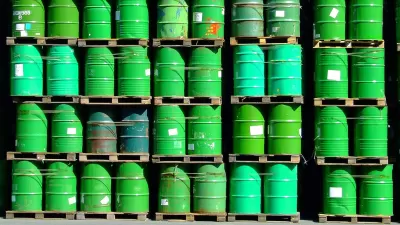American motorists are enjoying the lowest gasoline prices in five years because OPEC chose not to reduce oil output in the hopes that decreased oil prices will be lower than the cost needed to frack oil from shale.
Brad Plumer, senior editor of Vox, writes that the reason why oil prices went into a "freefall" on Friday, the day after OPEC members gathered in Vienna for an all-important meeting on Nov. 27 to deal with low oil prices was that "OPEC — a cartel of oil producers that includes Saudi Arabia, Iran, Iraq, and Venezuela ....couldn't agree on how to respond and did nothing."
OPEC's 12 members are responsible for 40 percent of world oil production, and perhaps more importantly, their exports account for "60 percent of the total petroleum traded internationally."
The result of not agreeing to respond to falling prices was that "(o)il prices promptly nosedived, with the price of Brent crude now hovering around $70 per barrel," writes Plumer. [In our last post on this topic on Oct. 16, Brent was priced at $89.] They are now at a five-year low, with gasoline prices following suit.
This marks a big shift in global oil politics. Essentially, OPEC is now engaged in a price war with oil producers in the United States. The cartel will let prices keep falling in the hopes that many of the newest drilling projects in the US will prove unprofitable and shut down."
Plumer goes on to provide the necessary background information to understand what took us here—how fracking and horizontal drilling in the United States have "added about 4 million new barrels of crude oil per day to the global market since 2008. (Global production is about 75 million barrels per day, so this is a significant number.)"
[Plumer cites the Nov. 17, Energy Information Administration (EIA) figure of 8.6 million barrels per day of crude oil and lease condensate production in August that doesn't include natural gas liquids (NGL).]
After the meeting, OPEC Secretary-General Abdalla El-Badri stated, "We will produce 30 million barrels a day for the next 6 months, and we will watch to see how the market behaves."
For all intents and purposes, OPEC is now engaged in a "price war" with the United States. What that means is that it's very cheap to pump oil out of places like Saudi Arabia and Kuwait. But it's more expensive to extract oil from shale formations in places like Texas and North Dakota. So as the price of oil keeps falling, some US producers may become unprofitable and go out of business. The result? Oil prices will stabilize and OPEC maintains its market share.
Will the OPEC strategy work and force U.S. oil production to slow down, if not decrease all together? Depends on whom you ask.
"Only about 4 percent of U.S. shale production needs $80 or more to be profitable, according to the Paris-based International Energy Agency (IEA)," according to a Bloomberg News article. "Most production in the Bakken formation, one of the main drivers of shale oil output, remains profitable at or below $42 a barrel, the IEA estimates. The agency expects U.S. supply to rise by almost 1 million barrels a day next year, with increasing flows to international markets."
Without going further into the geopolitics of the players—including the world's largest crude oil producer and second-largest oil exporter, Russia, I think it safe to say that the immediate beneficiaries to be the largest oil importing countries, and the United States, despite being the world's top oil producer when NGLs are included, is far away the largest.
FULL STORY: Oil prices keep plummeting as OPEC starts a price war with the US

Trump Administration Could Effectively End Housing Voucher Program
Federal officials are eyeing major cuts to the Section 8 program that helps millions of low-income households pay rent.

Planetizen Federal Action Tracker
A weekly monitor of how Trump’s orders and actions are impacting planners and planning in America.

Ken Jennings Launches Transit Web Series
The Jeopardy champ wants you to ride public transit.

Washington Legislature Passes Rent Increase Cap
A bill that caps rent increases at 7 percent plus inflation is headed to the governor’s desk.

From Planning to Action: How LA County Is Rethinking Climate Resilience
Chief Sustainability Officer Rita Kampalath outlines the County’s shift from planning to implementation in its climate resilience efforts, emphasizing cross-departmental coordination, updated recovery strategies, and the need for flexible funding.

New Mexico Aging Department Commits to Helping Seniors Age ‘In Place’ and ‘Autonomously’ in New Draft Plan
As New Mexico’s population of seniors continues to grow, the state’s aging department is proposing expanded initiatives to help seniors maintain their autonomy while also supporting family caregivers.
Urban Design for Planners 1: Software Tools
This six-course series explores essential urban design concepts using open source software and equips planners with the tools they need to participate fully in the urban design process.
Planning for Universal Design
Learn the tools for implementing Universal Design in planning regulations.
Heyer Gruel & Associates PA
Ada County Highway District
Institute for Housing and Urban Development Studies (IHS)
City of Grandview
Harvard GSD Executive Education
Toledo-Lucas County Plan Commissions
Salt Lake City
NYU Wagner Graduate School of Public Service



























